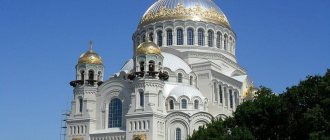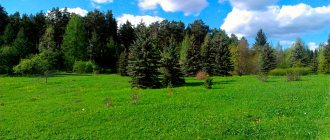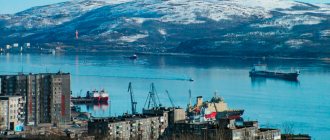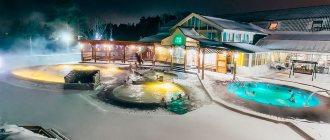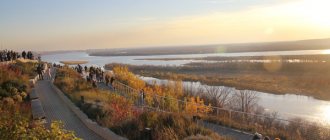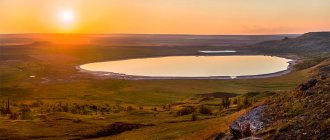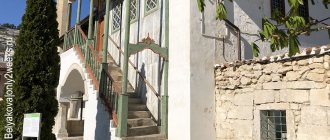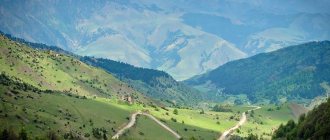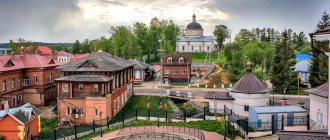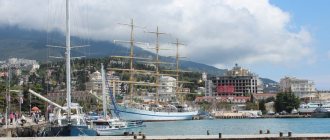Sights of Kronstadt in 1 day
Naval St. Nicholas Cathedral
Naval St. Nicholas Cathedral
The huge cathedral took 10 years to build - from 1903 to 1913. It was dedicated to the memory of fallen military sailors. The massive building is located on a spacious square in the city center. The cathedral is visible from afar, as its height is more than 70 meters. This is how it was intended: not only as a ritual structure, but also as a maritime landmark.
The cathedral was created in the neo-Byzantine style. The walls of the temple are lined with light marble. The domes are decorated with ornaments. There are even several stained glass windows, which is atypical for Russian church architecture. The interior contains elements of marine decor - anchors, images of fish and ships.
The temple is considered the largest “sea” temple in Russia. Divine services are held here daily. Connoisseurs of church architecture should visit here.
Address: Anchor Square, Kronstadt, St. Petersburg
Opening hours: daily from 9:00 to 19:00
Cast iron pavement
Cast iron pavement
The road surface made of cast iron hexagons (checkers) is located near the Admiralty of Peter 1, not far from the Naval Cathedral.
Historians say that the director of the Steamship Plant saw a similar coating in America. He brought cast iron checkers to Kronstadt. Since 1860, “cast iron streets” began to be built in the city.
Ordinary city pavements were always dilapidated (due to swampy soil). But the cast iron coating lasted without repair for more than 80 years. It was dismantled for military needs in 1941. There are only a couple of small areas left.
The pavements deserve attention as a unique example of an urban road surface from the 19th century.
Address: Kommunisticheskaya street, Kronstadt, St. Petersburg
Blue Bridge and Kronstadt Footpost
Blue Bridge and Kronstadt Footpost
The bridge over the Obvodny Canal on Makarova Street was built at the end of the 18th century. The building of that time was made of wood. Then, in 1873, it was replaced by a metal structure, and in 1964 - by reinforced concrete.
Near the abutment (shore support) of the bridge there is a foot rod (water level meter). It was installed in 1840 to monitor water levels in the Baltic Sea. The footstock is notable for the fact that it was taken as the standard for measuring heights throughout the USSR.
Address: Makarovskaya street, Kronstadt, St. Petersburg
Anchor Square
Anchor Square
The most famous square of Kronstadt. The Naval Cathedral is located on it, a little further on the Cast Iron Pavement. The name Anchor Square was given in 1993. At the beginning of the 20th century it was called Razvodnaya Square, later - Victims of the Revolution. But among the people it has always been known as Anchor. This name was officially assigned to it in 1993.
The place is interesting for lovers of Russian history. In 1921, a rally of sailors took place, which marked the beginning of the Kronstadt uprising.
Address: Anchor Square, Kronstadt, St. Petersburg
Petrovskaya pier
Petrovskaya pier
The pier is located in the Middle Harbor. It began to be created back in 1714. At first it was a modest wooden structure. In the second half of the 19th century, the pier was seriously rebuilt - the bottom was deepened and lined with granite.
The second name of the pier is Winter. Warships are present here at any time of the year. The harbor is specially cleared of ice. Tourists appreciate the marina for its seascapes and the opportunity to take photos of ships at rest.
Address: Kommunisticheskaya, 2, Kronstadt, St. Petersburg
Wooden lighthouse
Wooden lighthouse
Built in 1888. Located on the pier, between Srednyaya and Kupecheskaya harbors. This tall white tower can be seen from afar. The part of the pier on which the building sits is open. So you can get closer to the lighthouse (but not inside).
One of the most popular places for photo shoots in the city. All the tourists take selfies here, and the locals don’t lag behind.
Address: Petrovskaya Pier, Kronstadt, St. Petersburg
Complex of protective structures
Complex of protective structures
The Kronstadt Dam stretches across the Gulf of Finland (the official name is “Complex of St. Petersburg Flood Protection Structures”). Construction of the structures began in 1979 and was completed in 2011.
The complex consists of 11 dams, several hydraulic structures and a highway. The latter goes through Kronstadt. This is the only land road connecting the city and the mainland.
The dam offers picturesque views of the Gulf of Finland and the Baltic Sea. These places are also famous for year-round fishing.
Address: Kronstadt, St. Petersburg
Walking route on your own on the map
A map with the attractions indicated on it will help you plan a route for a walk through the city streets. You can download the map here.
A leisurely walk around the city will take 3-4 hours if you move around the city on foot. So feel free to take your children with you. You can leave your car at the Vladimir Cathedral near the entrance to the city.
If you plan to travel by car, you can park it near the embankment opposite the Italian Palace and next to Anchor Square. If there is not a large influx of tourists, there will always be a place.
Where to go in Kronstadt and what else to see
Makarovsky Bridge
Makarovsky Bridge
A pedestrian suspension bridge spans the Ravine Park. According to legend, it was built in a hurry to coincide with the opening of the Naval Cathedral in 1913. The building was rebuilt several times. In the 70s of the 20th century, major repairs were carried out and the outdated bridge frame was replaced.
A pleasant place for a walk, as well as a favorite place for photo sessions of newlyweds.
Address: Anchor Square, Kronstadt, St. Petersburg
Museum of the History of Kronstadt
Museum of the History of Kronstadt
Began work in 1991. The main exhibition is located in a house on Yakornaya Square, and a branch of the museum is located on Leningradskaya Street. The exhibition on the square is dedicated to the history of the city. Here you can see historical documents, photographs, household items of townspeople and sailors.
The branch houses an exhibition of Underwater Archeology. The exhibits are items recovered from sunken ships. The museums will interest history buffs of any age.
Address: Yakornaya Square, 2a, Kronstadt, St. Petersburg
Opening hours: daily from 11:00 to 18:00; Wednesday - closed
Entrance: for adults - 300 rubles, for children - 150 rubles, children under 7 years old - free
Summer garden
Summer garden
Broken in the historical heart of the city. The garden began in the 18th century. Then, on the site of the Central Alley, “Petrovskaya Perspektiva” was located - the first street of the young city. On it stood the house of Peter 1, surrounded by flower beds and linden trees.
The house has not survived to this day. And the flower garden and alley grew into a whole park. This is a quiet place, ideal for families with children.
Address: Krasnaya street, 8, Kronstadt, St. Petersburg
Italian Palace
Italian Palace
The oldest building in the city. The palace was built in 1717 for Prince Menshikov. This three-story house was built in the Peter the Great Baroque style. But later the building was rebuilt more than once. Now it’s difficult to understand what it was like originally.
The palace is interesting for its history and connections with legendary personalities.
Address: Makarovskaya street, 3, Kronstadt, St. Petersburg
Monument to Admiral Fyodor Ushakov
Monument to Admiral Fyodor Ushakov
The monument to the famous commander was erected in 2015. It is located north of the Naval Cathedral, closer to Sovetskaya Street. There is a bronze sculpture of the admiral on a granite pedestal. The author of the monument is Vladimir Gorevoy. Fyodor Ushakov is depicted in full height. The admiral is wearing a cloak and an ancient headdress - a bicorne.
Fans of the “invincible” admiral should definitely come here. After all, according to historians, Ushakov did not lose a single naval battle.
Address: Anchor Square, Kronstadt, St. Petersburg
Petrovsky Park and monument to Peter I
Petrovsky Park and monument to Peter I
Not far from the Summer Garden is the ancient Petrovsky Park. It was founded by Thaddeus Bellingshausen in 1845. By his order, a monument to Peter 1 was erected here. The park is adjacent to the Winter Harbor.
Here you can calmly admire the wonderful panoramas of the Gulf of Finland and the sight of warships in the harbor.
Address: Arsenalny lane, 5, Kronstadt, St. Petersburg
Catherine Park
Catherine Park
The park stretches along the Obvodny Canal in the area of Sovetskaya Street. The governor of Kronstadt, Admiral Bellingshausen, ordered the creation of the park in 1839. Previously, this place was Arsenalnaya Square.
The park is small, more like a square. It is surrounded on all sides by an elegant cast-iron fence. Although the center is nearby, there are not many people here. The place will appeal to lovers of lonely walks.
Address: Sovetskaya street, 15, Kronstadt, St. Petersburg
Cathedral of the Vladimir Icon of the Mother of God
Cathedral of the Vladimir Icon of the Mother of God
The date of construction of the cathedral is 1879. This is a tall, slightly elongated building with onion domes. The cathedral was built in an eclectic style with elements of pseudo-Russian style.
The religious building suffered greatly under Soviet rule. Since 1999, large-scale restoration work has been carried out in the temple. Now the church is open to visitors, and church services are held there daily.
Address: Vladimirskaya street, 32, Kronstadt, St. Petersburg
Opening hours: daily from 9:00 to 20:00
Free admission
Official website: https://vladimirsobor.ru/
Gostiny Dvor
Gostiny Dvor
The architectural complex was erected slightly away from the city center. It stretches along Lenin Avenue and Marx Street. The buildings were created in 1874. Gostiny Dvor was previously located on this site, but was destroyed by fire. The buildings of the complex are built in classicism style.
At the beginning of the 21st century, restoration of the buildings was carried out. Now it is a spacious shopping and entertainment complex. Shoppers will love this place. In addition, there are many cafes and restaurants.
Address: Lenin Avenue, 16, Kronstadt, St. Petersburg
Opening hours: daily from 10:00 to 20:00
Official website: https://www.gdkronshtadt.ru/
Drama Theater of the Baltic Fleet
Drama Theater of the Baltic Fleet
Began work in 1930. The theater was originally created as a naval theater. Therefore, his repertoire was specific. Almost all ideas were about wars, uprisings, rebellions. After the Second World War, the theater moved to the Baltic city of Liepaja. And he will return to Kronstadt only in 1991 after the collapse of the USSR.
Now the theater is located in the historical building of the Maritime Assembly. His repertoire is already less “militarized”. Theater buffs should attend his performances.
Address: Sovetskaya street, 43, Kronstadt, St. Petersburg
Official website: https://dtbf.ru/o-teatre/kontakty/
Lighthouse Museum
Lighthouse Museum
The young museum opened in 2022. Its exhibitions are located in the former barracks of the fort “Grand Duke Constantine”. There you can see lighting fixtures, navigation devices, and old maps.
Some exhibits are unique. So in the collection there is a Fresnel lens created in the mid-19th century. The museum is interesting for both adults and children.
Address: Fort "Grand Duke Constantine", Kronstadt, St. Petersburg
Opening hours: daily from 12:00 to 20:00; Monday - closed
Entrance: for adults - 400 rubles, for children - 300 rubles.
Kronstadt Maritime Museum
Kronstadt Maritime Museum
This private museum was established in 2012. Almost all of the museum's exhibits are dedicated to diving. Two expositions are presented. The first one talks about the history and traditions of Russian divers. And the second describes the work of submariners during the Second Patriotic War.
If you dreamed of becoming a diver as a child, then you should come to the museum.
Address: Andreevskaya street, 5, Kronstadt, St. Petersburg
Opening hours: Wednesday, Friday, Saturday, Sunday, from 11:00 to 18:00
Museum-apartment of John of Kronstadt
Museum-apartment of John of Kronstadt
The museum opened its doors in 1999. These are two rooms located in the house where the saint lived half his life. It is interesting that immediately after the death of Father John (1908), a church was built in his house. Under Soviet rule, the house was turned into a communal apartment, even changing the layout.
They began to recreate the saint’s apartment in 1995, not by the authorities, but by private individuals. In the museum, it is worth paying attention to the office with a recreated environment.
Address: Posadskaya street, 21, apt. 13, Kronstadt, St. Petersburg
Opening hours: daily from 12:00 to 17:00; Tuesday - closed
Entrance: for adults - 50 rubles.
Kronstadt Admiralty
Kronstadt Admiralty
The building is from the late 18th century. The building is located near Petrovsky Dock. There is an amazing story associated with this attraction. It was planned to move the Admiralty (Naval Ministry) here from St. Petersburg. Large-scale construction took place for more than 12 years (from 1785 to 1797), and then... the move was cancelled.
So the entire architectural complex remained idle. Nobody really needs buildings. They stand closed, slowly crumbling. We need to see if they're still intact.
Address: Karl Marx street, 13, Kronstadt, St. Petersburg
Petrovsky dock
Petrovsky dock
The oldest engineering structure in Kronstadt. It began to be built under Peter the Great in 1719, and was completed under Empress Elizabeth in 1752. The dock was used for ship repairs. He coped with his task quite well for another 70 years.
Now this is a rather neglected place that looks worse every year. But history buffs still come here.
Address: Kronstadt, St. Petersburg
Reserve "Western Kotlin"
Reserve "Western Kotlin"
The reserve was established in 2012. Located in the western part of Kotlin Island. The total area is 102 hectares. The place is well equipped: there are wooden decks for eco-trails, an ornithological tower, and information stands.
This is a great place to relax with family or company. In addition to the beautiful nature, you can have a picnic here at a special parking lot with a brazier.
Address: Kronstadt highway, 47, Kronstadt, St. Petersburg
Lighthouse Tolbukhin
Lighthouse Tolbukhin
The oldest lighthouse in the Baltic is located 5.5 km from the Reef fort. The wooden structure was erected back in 1719 by order of Peter 1. In 1810, the wooden building was replaced by a stone one, plus a guardhouse and gallery were built.
The tall (30 meters) white tower has survived to this day. Moreover, the lighthouse is still working, and the keeper lives there.
Address: Kronstadtskoe sh., 74, St. Petersburg
City Beach
City Beach
In the southeastern part of Kronstadt there is a city beach. The beach is sandy - the sand is renewed every summer. The beach is well equipped - wooden paths, cabins, toilets. Lifeguards work during the day. Sun loungers and umbrellas can be rented.
The place is relatively sparsely populated when compared to other beaches in St. Petersburg. There is a good children's playground.
Address: Toulonskaya alley, 7, Kronstadt, St. Petersburg
Opening hours: daily from 9:00 to 22:00
Museum of the History of Kronstadt (Anchor Square, 2a, Leningradskaya Street, 2)
Unique exhibits that tell about the life and history of the city are collected in the museum, founded in 1991. In honor of the thirtieth anniversary, an exhibition “How is a museum organized?” has been prepared. The authors of the exhibition tried to tell what secrets the historical institution keeps. Documents, photographs and objects from all 12 funds of the cultural institution appeared on display cases.
Nevskie News / Valeria Petrik
The organizers claim that by visiting the exhibition, you can see that Kronstadt is a port city, which is famous not only for its naval achievements. At all times, a rich cultural, economic and social life was in full swing on the island of Kotlin.
Nevskie News / Valeria Petrik
Forts of Kronstadt
Fort "Emperor Alexander I"
Fort "Emperor Alexander I"
Built in 1838–1845. It is essentially on the open sea. An artificial island was created especially for the fort. This is a three-story building with massive walls. Total area - 5000 sq. meters. This fort was nicknamed "Plague". The fact is that in 1897, plague research laboratories were located here.
At one time they took people here on excursions, but now the fort is closed. Reconstruction will continue until 2025.
Address: Kronstadt, St. Petersburg; GPS: 59.98936, 29.71804
Fort "Kronshlot"
Fort "Kronshlot"
The structure was built in 1704. Located south of Kronstadt. This is the first Russian fort in the Baltic. The creation of Kronshlot is considered the beginning of the city’s existence. The structure withstood several attacks during the Northern War. In the mid-19th century, the fort's military importance declined. And at the end of the 20th century it was completely abandoned.
It is best to go here with a guide who can tell you about the historical events associated with the attraction.
Address: Kronstadt, St. Petersburg; GPS: 59.97943, 29.74865
Forts "Obruchev" and "Totleben"
Forts "Obruchev" and "Totleben"
Two large forts are located north of the city. They were erected in 1896–1967. Then almost the entire Kronstadt Fortress was reconstructed.
Both buildings took part in the Russian-Finnish and Second World Wars. Since the mid-20th century, “Obruchev” was practically abandoned, and the Ministry of Emergency Situations (Ministry of Emergency Situations) station was located in the “Totleben” building. Fans of naval history should come here.
Address: Kronstadt, St. Petersburg; GPS: 60.05932, 29.72059
Fort "Reef"
Fort "Reef"
The fortification was created at the end of the 19th - beginning of the 20th century. The fort is located in the western part of Kotlin Island. In the first half of the 20th century, "Reef" took part in hostilities. Participants of the Kronstadt uprising in 1921 left for Finland. During the blockade, the ice defense of Leningrad was carried out from here.
In 2014, the “Reef” ceased to be a sensitive facility and could be visited independently. And in 2022 it was restored. Now you can go to the “Reef” with an excursion group.
Address: Kronstadt, St. Petersburg; GPS: 60.03191, 29.63779
Opening hours: Monday - Friday from 14:00 to 22:00; Saturday - Sunday from 11:00 to 22:00
Entrance: for adults - 350 rubles, for children under 8 years old - free
Museum "Dutch Cuisine" (Makarovskaya street, 2a)
“Dutch Kitchen” is a new museum dedicated to one of the oldest buildings in Kronstadt. Guests will learn the history of the creation, prosperity and transformation of Dutch Cuisine. Those who come will be able to see the building in the era of Peter the Great, feel its atmosphere, find out what an important role it played, understand the reasons for its decline, and also see with their own eyes the stage of revival, the second life of this place. The museum is equipped with the latest modern technologies in order to tell its story as fascinatingly as possible.
Nevskie News / Valeria Petrik
Nevskie News / Valeria Petrik
Nevskie News / Valeria Petrik
The Model Forts Museum and the Dutch Kitchen Museum will open to visitors on June 1. The day before, the exhibition “Museum Collection. Military Artist", which is dedicated to the celebration of the 76th anniversary of Victory in the Great Patriotic War.
Might be interesting
Sights of St. Petersburg
The most beautiful bridges of St. Petersburg
Top places in Vyborg
Where to go in Pskov
Top attractions of Peterhof
What to visit in Petrozavodsk
What to see in Tver
Petrovsky dock
Address: Petrovsky Dock Canal
View of the dock from Makarovskaya Street:
A monument to the mind and ingenuity of Peter the Great. Built for quick repair of ships entering the port. Letters from Dutch engineers have been preserved. Peter set them the task of designing a dry dock, from which water could be pumped out in less than a month. In their letters, the Dutch touchingly fantasize about steam pumps that have not yet been invented, capable of fulfilling the sovereign’s task, but classify them as unrealistic theorizing. Peter solved the problem radically: using the manpower of captured Swedes and peasants, he created a dock, the water from which flowed into a lake located below the dock level.
The project expanded and dragged on: a canal was dug, a wind tower-water pump was built. Peter did not see his docks ready; construction was completed after his death. But the dock, drained in less than a month, with a capacity of ten ships, served sailors for another 75 years before the invention of the steam pump.
FAQ
Where can you go with children in Kronstadt? Cast iron pavement, Blue Bridge and Kronstadt footstock, Anchor Square, Wooden lighthouse, Monument to Admiral Fyodor Ushakov, Petrovsky Park and the monument to Peter I, Catherine Park, Kronstadt Admiralty, Petrovsky Dock, City Beach, Fort Kronshlot, Fort Reef.
What sights in Kronstadt should a tourist see first? Marine St. Nicholas Cathedral, Cast Iron Pavement, Blue Bridge and Kronstadt Footpost, Petrovskaya Pier, Wooden Lighthouse, Complex of Protective Structures.
What sights of Kronstadt can you see on your own? Obvodny Canal, Monument to the Siege Stickleback, Monument to S.O. Makarov, Cast Iron Pavement, Blue Bridge and Kronstadt Footstock, Petrovskaya Pier, Makarovsky Bridge, Summer Garden, Catherine Park, Cathedral of the Vladimir Icon of the Mother of God.
Museum "House of Lighthouses" (Kommunisticheskaya street, 1)
The Lighthouse Museum is located on the territory of Fort Constantine. However, the creators and ideological inspirers of the museum considered that one point for a complete immersion in the history of lighthouses would not be enough. Therefore, near Petrovsky Park, in Kronstadt itself, the House of Lighthouses museum opened in the winter of 2021. It can be considered a subsidiary of the Lighthouse Museum. You can see many different models in the house, as well as visit the lighthouse keeper's room.
Nevskie News / Valeria Petrik
Nevskie News / Valeria Petrik
Nevskie News / Valeria Petrik
Nevskie News / Valeria Petrik
Not long ago, the parrot Prosha settled in the museum, who loves to greet guests, sit on their shoulders and willingly look at the exhibits together with visitors.
Nevskie News / Valeria Petrik
Best hotels in Kronstadt
Related materials:
- 43 best attractions in Minsk,…
- 29 best attractions in Orel,…
- 31 attractions of Novorossiysk to visit
- 33 attractions of Bakhchisaray that are worth visiting
- 38 sights of Pskov recommended for…
- 29 best attractions of Chelyabinsk,…
- 28 best attractions in Belgorod,…
- 32 best sights of Tyumen that…
- 30 sights of Pereslavl-Zalessky,…
Did you like the article? Share with friends:
1
Cathedral of the Vladimir Icon of the Mother of God
Address: Kronstadt, Vladimirskaya st., building 32 Telephone: , 311-53-30 Website: https://www.kronshtadt-pravoslavny.ru/svyatiny/hrami/vladimirsky/ Opening hours: daily from 09:00 to 20 :00 (the Upper or Lower Church is open), schedule of services
The history of the cathedral begins in 1730, but a century later the buildings and chapel were destroyed by fire, and it received new life only in 1875, changing the status of a garrison church to the status of a cathedral.
In the 1950s, at the peak of anti-religious sentiment, there were three attempts to blow up the building in order to build a library in its place, but the cathedral miraculously survived, and attempts to destroy it were abandoned because nearby houses were damaged.
The restoration did little to change the original appearance of the cathedral: it is eclectic. Preserving the traditions of Russian architecture, the architects combined them with elements of Gothic and Byzantine style.
Near the cathedral you will see:
- Stone chapel from 1870
- The grave of Archpriest Vasily Saltykov (1898)
Interesting Facts
- Kotlin Island did not always belong to Russia. It was in the possession of Sweden, but Peter I, understanding the importance of its location, did the impossible - in a few months he built a fort, through which not a single enemy ship could break through. The Swedes also failed to return Kotlin to their possessions. After making several attempts, they were forced to recognize the superiority of the Russian fleet and retreat.
- According to legend, while retreating from the fort, Swedish troops left a hot pot with delicious food, which was discovered by Peter I. Thus, the island got its name - Kotlin.
- More than 40 expeditions around the world were sent from Kronstadt and 56 large-scale geographical discoveries were made.
- In 1874, a major fire destroyed more than half of the city. This sad moment is depicted by Alexey Bogolyubov in a painting, which can be viewed at the Museum of Fine Arts of the Republic of Tatarstan or on their official website.
- On Anchor Square there is the only pavement in the world made of cast iron blocks. Unfortunately, only a small part of it has reached us.
Andrew's Garden
Andreevskaya Street will lead you to the park , which is the oldest garden in Kronstadt. This place is famous not only for its beauty, but also for its historical significance.
In the center of the square there used to be St. Andrew's Cathedral, which helped people survive all the hardships of the First World War. Unfortunately, the temple was destroyed in 1932, and the park now preserves only memories of it.
